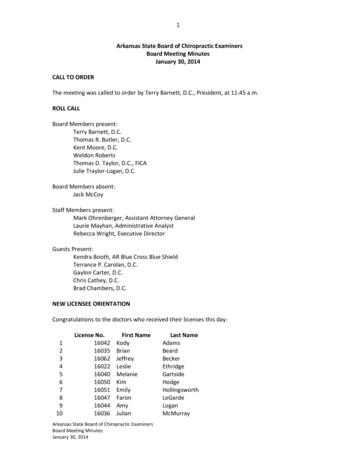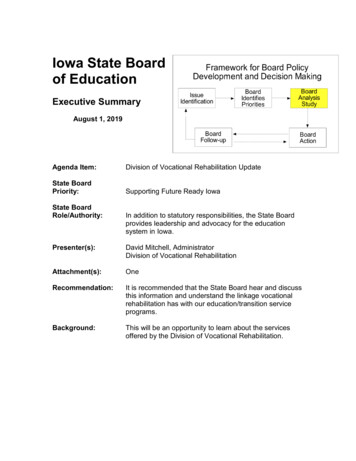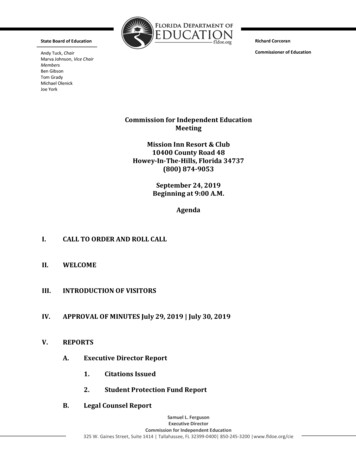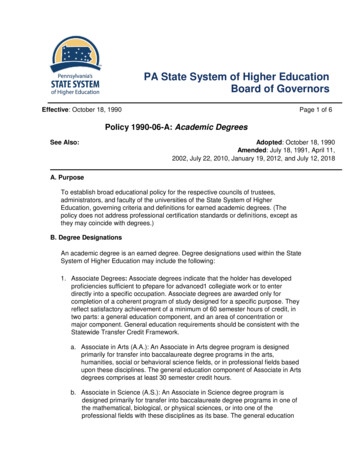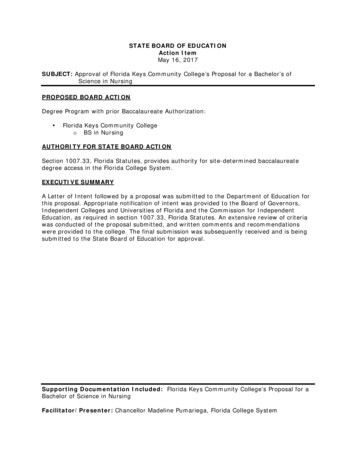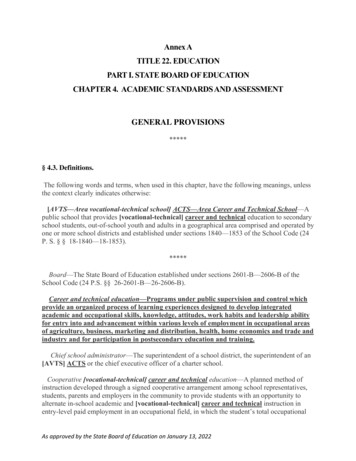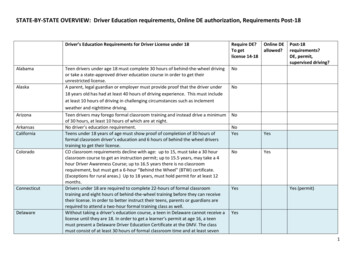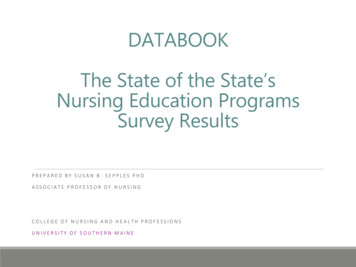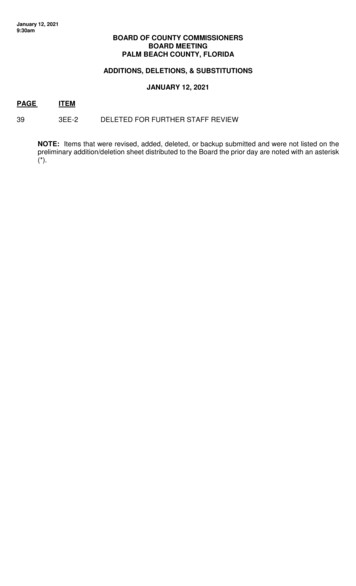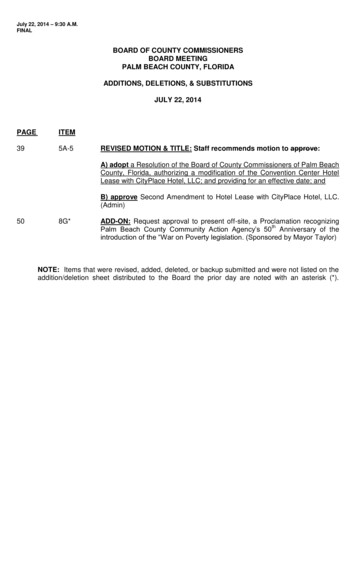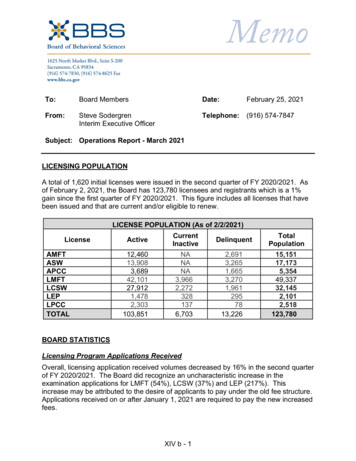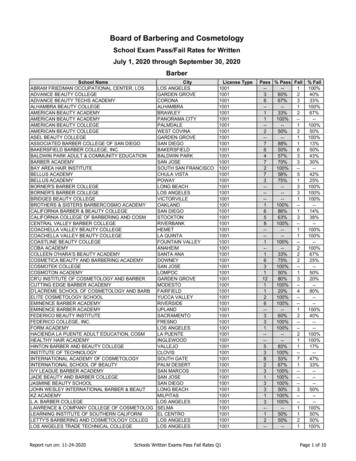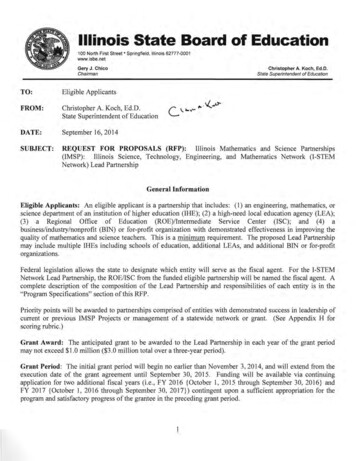
Transcription
1IIIinois State Board of Education100 North First Street Springfield, Illinois 62777-0001www.isbe.netGery J. ChicoChairmanChristopher A. Koch, Ed.D.State Superintendent of EducationTO:Eligible ApplicantsFROM:Christopher A. Koch, Ed.D.State Superintendent of EducationDATE:September 16,2014SUBJECT:REQUEST FOR PROPOSALS (RFP): Illinois Mathematics and Science Partnerships(IMSP): Illinois Science, Technology, Engineering, and Mathematics Network (I-STEMNetwork) Lead PartnershipGeneral InformationEligible Applicants: An eligible applicant is a partnership that includes: (1) an engineering, mathematics, orscience department of an institution of higher education (IHE); (2) a high-need local education agency (LEA);(3) a Regional Office of Education (ROE)/Intermediate Service Center (ISC); and (4) abusiness/industry/nonprofit (BIN) or for-profit organization with demonstrated effectiveness in improving thequality of mathematics and science teachers. This is a minimum requirement. The proposed Lead Partnershipmay include multiple IHEs including schools of education, additional LEAs, and additional BIN or for-profitorganizations.Federal legislation allows the state to designate which entity will serve as the fiscal agent. For the I-STEMNetwork Lead Partnership, the ROE/ISC from the funded eligible partnership will be named the fiscal agent. Acomplete description of the composition of the Lead Partnership and responsibilities of each entity is in the"Program Specifications" section of this RFP.Priority points will be awarded to partnerships comprised of entities with demonstrated success in leadership ofcurrent or previous IMSP Projects or management of a statewide network or grant. (See Appendix H forscoring rubric.)Grant Award: The anticipated grant to be awarded to the Lead Partnership in each year of the grant periodmay not exceed 1.0 million ( 3.0 million total over a three-year period).Grant Period: The initial grant period will begin no earlier than November 3,2014, and will extend from theexecution date of the grant agreement until September 30, 2015. Funding will be available via continuingapplication for two additional fiscal years (i.e., FY 2016 {October 1,2015 through September 30, 2016} andFY 2017 {October 1,2016 through September 30, 2017}) contingent upon a sufficient appropriation for theprogram and satisfactory progress of the grantee in the preceding grant period.
Letter of Intent: Eligible applicants are required to submit a non-binding letter of intent in order to beeligible to participate in this grant competition. A template for the letter of intent is provided asAttachment 11 and should be submitted electronically to Tara Bell at tbell@isbe.net no later thanMonday, October 13, 2014 at 5:00 PM CDT.Application Deadline: Mail the original application and two (2) copies and provide an electronic copyon a compact disc (CD) or flash drive to the Illinois State Board ofEducation, 100 North First Street, C 215, Springfield, Illinois 62777-0001, Attn: Tara Bell, Illinois Mathematics and Science Partnerships, toensure receipt no later than Monday, November 3, 2014 at 5:00 PM CDT. The original, two (2) copies,and an electronic copy on a compact disc (CD) or flash drive must be received by the due date in order forthe proposal to be considered. No late proposals, facsimile proposals, or electronic proposals will beaccepted. Substantially incomplete proposals will not be considered for funding.I-STEM Network Lead Partnership Webinar and Online Bidder's Forum: An I-STEM NetworkLead Partnership Program webinar will take place on Wednesday, September 24, 2014 at 1:00 PMCDT. Reserve your Webinar seat now at https ://wwwl.gotomeeting.com/register/343377200An online bidder's forum about this RFP is available at http://www.isbe.net/careerihtml/msp.htm. Allquestions and answers will remain on the electronic forum until Monday, November 3,2014. Applicantsare encouraged to review the information posted on the forum before sUbmitting their proposals.Should the conditions of this RFP change prior to the deadline for submission of proposals; the IllinoisState Board of Education (ISBE) will post the changes at http://www.isbe.net/career/html/msp.htm.Contact Person: For more information about this RFP, contact Tara Bell at 217/524-4832 or by email attbell@isbe.net.2
BackgroundThe state of Illinois has new learning standards for science and mathematics. In 2010, Illinois joinedmore than 40 states in a collaborative effort to raise learning standards and improve college and careerreadiness for all students with adoption of the Common Core State Standards (CCSS) in Mathematics andEnglish Language Arts. Referred to as the New Illinois Learning Standards (New ILS), they establishclear expectations regarding what students should learn in K-12 mathematics.In February 2014, ISBE adopted the Next Generation Science Standards (NGSS), referred to as the NewIllinois Learning Standards (New ILS). The timeline of full implementation occurs during the 2016-2017school year. The New ILS presents a new vision for K-12 science education that includes disciplinarycore ideas, cross-cutting concepts, and scientific and engineering practices.Title II, Part B, Sections 2201-2203, of the Elementary and Secondary Education Act (ESEA) authorizesthe Mathematics and Science Partnerships (MSP) program as a means to improve teacher quality in theserespective curricular areas. The purpose of the program is to increase the academic achievement ofstudents in mathematics and science by enhancing the content knowledge and teaching skills of classroomteachers. The U.S. Department of Education (ED) provides relevant information about this program e federal legislation identifies five (5) criteria to support the purpose of the MSP program. The purposeof the program is to improve the academic achievement of students in the areas of mathematics andscience by encouraging state education agencies (SEAs), IREs, LEAs, elementary schools, and secondaryschools to participate in programs that:1. improve and upgrade the status and stature of mathematics and science teaching byencouraging IREs to assume greater responsibility for improving mathematics and scienceteacher education through the establishment of a comprehensive, integrated system ofrecruiting, training, and advising mathematics and science teachers;2. focus on the education of mathematics and science teachers as a career-long process thatcontinuously stimulates teachers' intellectual growth and upgrades teachers' knowledge andskills;3. bring mathematics and science teachers in elementary schools and secondary schools togetherwith scientists, mathematicians, and engineers to increase the subject matter knowledge ofmathematics and science teachers and improve these teachers' teaching skills through the useof sophisticated laboratory equipment and work space, computing facilities, libraries, and otherresources that IREs are better able to provide than the elementary schools and secondaryschools;4. develop more rigorous mathematics and science curricula that are aligned with challengingstate and local academic content standards and with the standards expected for postsecondarystudy in engineering, mathematics, and science; and5. improve and expand training of mathematics and science teachers, including training teachersin the effective integration of technology into curricula and instruction.The IMSP Program has provided innovative, high-quality professional development opportunities for K 12 math and science teachers since 2005. IMSP has utilized two models for delivery of services toteachers: a graduate school model in which cohorts of teachers earned a master's degree in teachingmathematics or science and a Workshop Institute Program (WIP), which consists of an 80-hour summerworkshop followed by institutes taking place during the school year with focused professionaldevelopment on a specified topic. To date, there have been five rounds ofWIP. The fourth round (WIP4)3
which began in January 2012, focused on developing an understanding of the New ILS for mathematicsfor grades 6-12. The most recent grant (WIP5), which began January 1, 2013, provided professionaldevelopment activities for teachers in grades 6-12 to assist with implementation of the New ILS.Federal MSP legislation requires an engineering, mathematics, or science department of an IHE and ahigh-need LEA as the core entities comprising a partnership. However, multiple LEAs comprising theentire K-12 spectrum are also allowed.Additional entities are allowed and described html. Beginning in 2012, IMSP projects were requiredto include a business/industry/nonprofit (BIN) or for-profit entity as a partner. The purpose of thisenhanced partnership was to engage stakeholders in supporting math and science teachers by providingaccess to greater field-based resources, as well as access to professionals engaged in industry. Teacherscollaborating with BIN or for-profit partners can lead to opportunities for students to learn more about theskills necessary to be college- and career-ready. In addition, BIN and for-profit entities must also benefitfrom the partnership. Though the value of participation in the partnership may not be immediate, BINand for-profit organizations should experience economic and workforce development from the researchand talent pool that ensues. While each partnership may be unique in context and stakeholder groups,resources are available to provide examples of the characteristics or hallmarks of successful partnerships.Some hallmarks of successful partnerships include the following (adapted from Chicago STEM EducationConsortium's (C-STEMEC) "Implementing the Next Generation Science Standards: Hallmarks of //c-stemec.org/wp contentluploads/20 13/1Olhallmarks.p@: A partnership with colleges and universities that helps provide a high-quality education alignedwith new learning standards is characterized by pre-service teacher preparation programs that arelinked tightly with the actual expectations in the classroom with regard to curriculum andinstruction; A partnership with colleges and universities that helps provide a high-quality education alignedwith new learning standards is characterized by in-service professional development programs thatare linked tightly with the actual experience of teachers in their classroom as they implement thestandards; A partnership with informal institutions that helps provide a high-quality education aligned withnew learning standards provides both classroom and extra-curricular opportunities to facilitateteachers' implementation of the standards; A partnership with families and communities that helps provide a high-quality education alignedwith new learning standards is characterized by parents and others developing an appreciation ofthe level of rigor of their students' science education, and helps parents develop an appreciation ofthe beauty, wonder, and utility of science themselves; and A partnership with businesses that helps provide a high-quality education aligned with newlearning standards provides resources and opportunities for the study of science, math, andengineering that are not available in a school setting alone.Also addressed in the federal MSP legislation is the opportunity to provide professional development toK-12 math and science teachers. Providing math and science content-rich and research-basedprofessional development is the central focus of the I-STEM Network Partnerships Program. Animportant nleasure of student achievement in the Network will be utilizing what students experience inmathematics and science as evidence of academic growth.The central purpose of the MSP program is to provide professional development to teachers in order toincrease their mathematics and/or science content knowledge and their pedagogical skills. The guiding4
principle is that with deeper knowledge of the subject matter and understanding of effective instructionalstrategies, teachers will be able to in1pact their students' achievement in mathematics and science. Toaccomplish this goal, MSP projects work with a variety of teachers, across grades K through 12.Additionally, the program aims to increase the support structures in place for participating teachers bytraining teacher leaders and by promoting the instructional leadership of administrators (http://ed msp.net!images/public documents/document!annuaVMSP%20PP 11 %2 oAnnual %20Final%20Report.pdf)PurposeThe purpose of this RFP is to identify a Lead Partnership for the IMSP I-STEM Network Program. TheNetwork will function to provide equitable access to high-quality professional development and resourcesfor Illinois K-12 math and science teachers. The I-STEM Network Program will be implemented in two(2) stages. In stage one (l), ISBE is releasing this RFP for the purpose of funding a single eligiblepartnership to be the IMSP I-STEM Network Lead Partnership. In stage two (2), an RFP will be releasedto fund multiple I-STEM Regional Partnerships to join the I-STEM Network. These RegionalPartnerships will provide professional development through a Regional Workshop Institute Program (R WIP) n10del utilizing math and science resources coordinated by the Lead Partnership. The RFP for theR-WIPs will be released subsequent to this RFP. Only partnerships with the capacity to lead and managea statewide network and required deliverables described in this RFP should apply for the IMSP I-STEMLead Partnership Program. Other interested partnerships will have an opportunity to play an importantrole in the I-STEM Network through the subsequent Regional Partnerships RFP.Finally, it is expected that the IMSP I-STEM Network Program will include high-quality support andresources for teachers beyond the life of this grant. As a result, demonstrating sustainability of the 1 STEM Network is a key component of the Lead Partnership.Program SpecificationsOverviewAs noted in the "Background" section above, the successful applicant for this RFP will be an eligible LeadPartnership comprised of entities with a deep understanding of, and knowledge about, the New ILS, aswell as demonstrated effectiveness in improving the quality of math and science teachers. The fundedLead Partnership will have the responsibility of ensuring that the goals of the I-STEM Network Programare met and that the deliverables of the program are implemented statewide.I-STEM Network Program Goals:1. improve student performance in math and science through professional development and resourcedevelopment for K -12 teachers;2. develop classroom culture with learning opportunities for students and teachers by including high quality research-based instructional n1aterials such as ISBE Model Curriculum for Math andScience as well as others and providing support for the New ILS and Framework/or K-12 ScienceEducation;3. manage the I-STEM Network comprised of several R-WIPs consisting of at least 1 (one) math andone (l) science partnership per area except Area I and Chicago Public Schools (CPS) which canhave 2 (two) math and 2 (two) science partnerships per area due to size of population (seeAppendix G for an Area map). The R-WIPs must support teacher's understanding of high-qualitymath and science instruction incorporating the New ILS; give teachers access to mathematicians,scientists, and engineers (along with their technologies and resources) in order to help them5
develop their individual knowledge, skills, and resources; and help high-need LEAs prepare theirstudents to be positioned to be college- and career-ready in an innovative and globally competitivesociety;4. promote strong teaching skills by increasing instructors' understanding and application ofscientifically-based educational research appropriate to math and science teaching and learning;and5. build the capacity of math and science teacher leaders within a regional statewide context; assistIHE teacher education faculty and pre-service teaching candidates in understanding the vision andinstructional shifts outlined in the New ILS and Framework/or K-12 Science Education.These goals fonn the basis for the following deliverables of the IMSP I-STEM Network Lead PartnershipProgram that the successful applicant will be expected to implement. Each of these required deliverablesis more fully explained in the "Program Deliverables" section below.As stated in the "General Infonnation" section on page 1 of this RFP, the eligible applicant for the 1 STEM Network Lead Partnership must include the following: an engineering, mathematics, or sciencedepartment of an IHE; a high-need LEA; a ROE/ISC; and a BIN or for-profit organization. This is aminimum requirement. The proposed partnership may include multiple IHEs including schools ofeducation, additional LEAs, and additional BIN or for-profit organizations. However, eligible entities arereminded that several regional partnerships will be distributed geographically across the state in phase twoof the I-STEM Network and their expertise could be better-leveraged through such local partnerships.(See Appendix A for additional infonnation about each entity in an eligible partnership.)Program DeliverablesDeliverable 1: Provide leadership and management for the statewide I-STEM Network andestablish one (1) I-STEM Network PartnershipIn support of the I-STEM Network Program goals, the successful applicant will be required to provideleadership and oversight of the statewide I-STEM Network. In cooperation with ISBE IMSP staff, thefunded partnership and ISBE will identify a qualified person to undertake the role of I-STEM NetworkAdministrator. (See Appendix A for additional infonnation about leadership and oversight of the I-STEMNetwork and the required qualifications and process of naming the statewide I-STEM NetworkAdministrator. )The IMSP I-STEM Network Lead Partnership provides leadership and management responsibilities thatincludes, but is not limited to, the following: I-STEM Network Lead Partnership: Development of a highly-effective, balanced partnershipcapable of leading the important statewide work described in this RFP. A detailed description ofcomposition, requirements, and responsibilities of the partnership entities is included in AppendixA.I-STEM Network Experts: Mathematics and science capacity-building activities will befacilitated by national and state experts selected in collaboration between the funded LeadPartnership and ISBE IMSP staff.I-STEM Network Steering Committee: This committee will be appointed in collaborationbetween the funded Lead Partnership and ISBE IMSP staff. It will consist of representatives froma variety of stakeholder groups including entities such as partners, teachers, the external evaluator,the I-STEM Network Administrator, and ISBE IMSP staff. The committee will meet monthly to6
plan, monitor, and recommend adjustments to the statewide I-STEM Network for the duration ofthe grant. (See Appendix A for additional information.)I-STEM Network Capacity-Building: Organize and support the production and/or identificationof the I-STEM Network capacity-building resources described in Deliverables 2, 3, and 4 below.I -STEM Network Fiscal Agent: Management of federal funds for the Lead Partnership, as wellas fiscal guidance and budgetary oversight for the R-WIPs according to ISBE policies andprocedures. http://www.isbe.netlfunding/pdf/fiscal procedure handbkpdf.Collaboration with ISBE IMSP Staff: The I-STEM Network Lead Partnership will fullycollaborate with and provide necessary documentation to ISBE IMSP staff in order to maintainstrong coherence within the statewide I-STEM Network, provide regular updates on progress, andalign activities with related ISBE (and other state and national) initiatives coinciding to the over
Chico Christopher A. Koch, Ed.D. Chairman State Superintendent of Education . TO: Eligible Applicants . . bring mathematics and science teachers in elementary schools and secondary schools together with scientists, mathematicians, and engineers to increase the subject matter knowledge of . the
